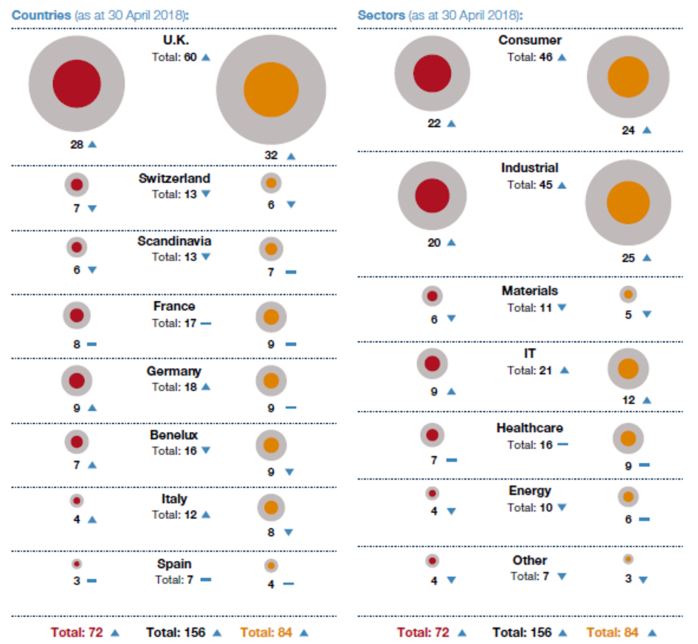13 Percent Rise In U.K. Companies at Significant Risk of Shareholder Activism
Activism is growing across Europe, as “wolf packs” of like-minded investors pool their strength to force debates with management.
The updated A&M Activist Alert identifies 60 U.K. companies as potential targets for activists.
Uneven performance by business division increases the likelihood of corporates being targeted.
London – Global professional services firm Alvarez & Marsal (“A&M”) today announces the findings of its latest analysis and predictor of shareholder activism in Europe, the “A&M Activist Alert”, or “AAA”. The AAA reveals that the number of U.K. companies predicted to be under threat from public activist targeting has risen 13 percent to 60 over the past 12 months.
General findings
- On average, U.K corporates are 46% percent more likely to be targeted than those from the other seven nations/regions analyzed in the AAA.
- Uneven performance by division increases the likelihood of being targeted by activists seeking to improve the performance of weak business units or force a spin-off.
- Activists are targeting larger companies: the average market capitalization of a predicted target company is now $17.58 billion, up from $16.48 billion compared to our September report (up 6.7 percent versus the FTSE All Share index, up 1.3 percent over the same period).
- Activism is growing across Europe: more capital and more willing participants mean that “wolf packs” of like-minded investors, with the critical mass to force a debate can form more easily and more quickly.
Activism by sector and region
- Consumer companies make up the largest number of entries on the lists of corporates at risk, as they seek to adapt to continued market disruption from evolving retail channels, squeezed consumer spending and rising costs. The industrials and IT sectors are also seen as particularly at risk. On average, the consumer sector is 23% more likely to attract public activism, whilst the industrials sector is 13% more likely.
- By contrast, the energy and materials sectors are dropping off the activist radar as commodity prices recover, boosting profits and share prices. Indeed, the materials sector is now 15% less likely to be targeted, with energy companies 19% less likely.
- From a geographic perspective, companies based in the U.K., Germany, France and Italy have all became more attractive to activists, while Swiss and Scandinavian companies became less so. It is notable that Scandinavian corporates make up 19% of the total data set analyzed, but only 8% of the predicted targets.
Board makeup and responsiveness
- Activists are becoming more impatient, granting Boards less time to address underperformance. The average time between first evidence of underperformance and public activism has reduced from just over 2 years in 2016 to 1.8 years now.
- Gender balance matters. There are continuing indications that increasing the number of women on a Board may be associated with a reduced risk of shareholder activism.
A&M Activist Alert
The AAA is the most comprehensive statistical analysis of its kind. The analysis focuses on 1,715 corporates with a market capitalization of US$200 million or more, listed and headquartered in the U.K., Germany, France, Scandinavia, Switzerland, Benelux, Italy and Spain. In this report, the analysis has been extended to also track changes in corporate performance by business unit – a key area of focus for activists. The resulting predictive model successfully predicted 59 percent of corporates publicly targeted by activists since January 2015. The report is published twice yearly and individual companies can check their position on the Alert List by contacting A&M.
Malcolm McKenzie, Managing Director and Head of European Corporate Transformation Services, said: “Activism is growing across Europe. One phenomenon that we are seeing is “wolf packs” of like-minded investors, who are pooling their strength to force a debate with management. It is becoming clear that they are forming more easily and more quickly, and increasingly they are setting their sights on larger companies. Businesses with conglomerate models or uneven divisional performance face growing levels of scrutiny from investors seeking to push management to increase shareholder value.
“While declining shareholder returns are an initial point of interest for activists, there are many other significant factors. Boards need to take a broader perspective and often benefit from an “outside-in” perspective. A Board that sees the warning signs should act pre-emptively to avoid the considerable financial, reputational and disruptive risks that can accompany a public activist campaign. In this heightened environment, it is crucial for Boards to move decisively to ensure meaningful change is delivered before the “wolf pack” closes in.”
-ENDS-
Notes to Editors
The AAA model

Key findings summarized
Quarterly refreshes
The A&M Activist Alert model is fully reassessed and refreshed every three months including a fully updated review of all known activist actions. This allows us to see how the key variables, timescales, country and industry factors have moved in terms of relative importance. A&M also reviews which companies have moved in or out of the Red or Amber Lists.
This May 2018 analysis is accompanied by a focused report that explains the methodology plus the key findings and clear messages of importance to corporates and their Boards seeking to avoid the high potential financial and reputational costs associated with a public activist programme. Individual companies can check their position on the Alert List by contacting A&M.
Red and Amber Lists
The AAA model calculates a score for all analyzed corporates that predicts the likelihood of public activist action. Companies with high AAA Scores, and therefore with a higher predicted likelihood of public targeting, are classified as either Red or Amber. These classifications are based on the level of AAA Score and how sustained it has been over the past two years.
Corporates with high AAA Scores on both the two year and one year bases are considered to be at high short term risk (next six to 12 months) of public activist action and may already be subject to non-public approaches. Such high-risk corporates feature on the Red List. Companies with a high AAA Score on either the two year or one year basis are likely to be being monitored by activists. Such companies are considered to be at medium risk which will only increase if corrective action is not taken within 12 to 18 months. Such medium risk corporates feature on our “Amber List”.
About Alvarez & Marsal
Companies, investors and government entities around the world turn to Alvarez & Marsal (A&M) when conventional approaches are not enough to activate change and achieve results.
Privately held since 1983, A&M is a leading global professional services firm that delivers business performance improvement, turnaround management and advisory services to organizations seeking to transform operations, catapult growth and accelerate results through decisive action. Our senior professionals are experienced operators, world-class consultants and industry veterans who leverage the firm's restructuring heritage to help leaders turn change into a strategic business asset, manage risk and unlock value at every stage. A&M now has more than 300 professionals serving major private equity and multinational corporates in Europe, up from some 30 people five years ago.
When action matters, find us at alvarezandmarsal.com.
Follow A&M on LinkedIn, Twitter and Facebook.
###
CONTACT:
Henry Wallers, Emma Ruttle, Headland Consultancy PR, +44 (0)203 805 4839
Margaret Cameron-Waller, Director of Marketing U.K. & Europe, Alvarez & Marsal, +44 (0)207 715 5202



